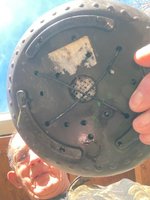DrTolhur
Mame
The standard form for bonsai pots is to have fairly large (quarter-ish sized) drainage holes with maybe some smaller wire holes. But then you need to put some kind of screen over the holes, and sometimes the drainage isn't ideal if there's only one in the middle. Why aren't bonsai pots made with more tiny holes all around the bottom, which would allow for more even drainage and also not require use of screens? It seems preferable to me, but I've never seen it, so I assume there's a good reason it's not done.
Does it not actually provide ideal drainage? Is it just too hard/time consuming to do? Would it cause the ceramic to break while firing?
(I've seen some of the training pots that have something akin to a combination drainage hole/screen in the bottom, but I've never seen it with ceramics, and even those still localize the holes rather than all over.)
Does it not actually provide ideal drainage? Is it just too hard/time consuming to do? Would it cause the ceramic to break while firing?
(I've seen some of the training pots that have something akin to a combination drainage hole/screen in the bottom, but I've never seen it with ceramics, and even those still localize the holes rather than all over.)





